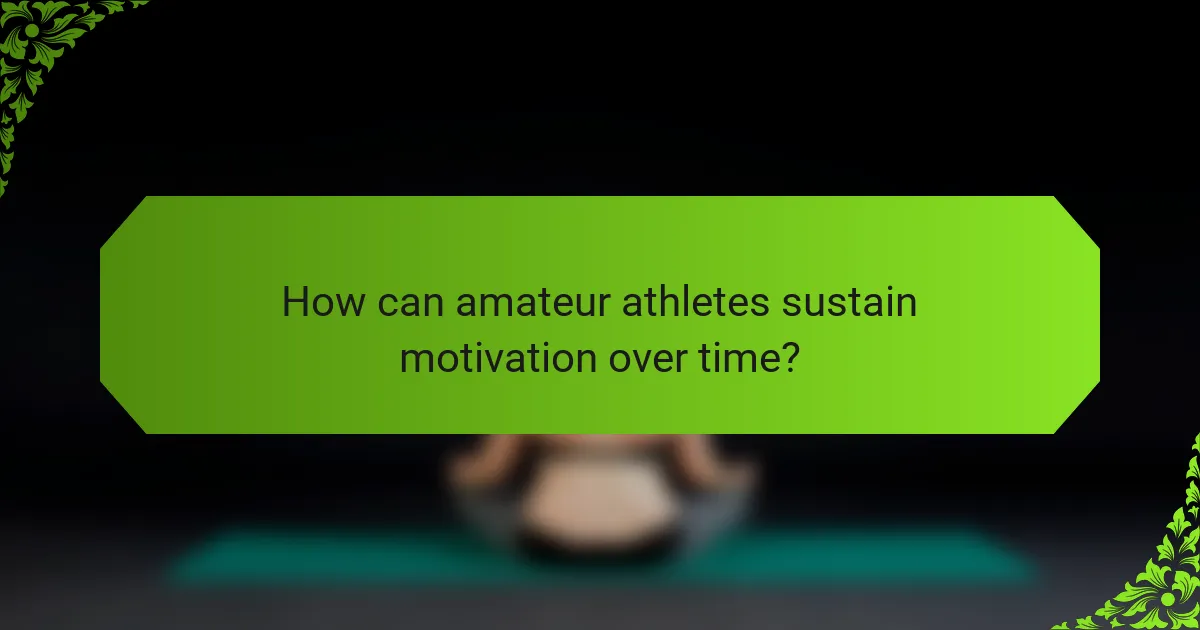Resilience practices are crucial for athletes seeking to build mental toughness and overcome setbacks. This article explores foundational techniques like mental conditioning, goal setting, and positive self-talk. It also addresses unique challenges faced by amateur athletes and highlights rare techniques such as visualization and cognitive restructuring. Lastly, it emphasizes the importance of sustaining motivation through support systems and consistent goal-setting.

What are the foundational resilience practices for amateur athletes?
Foundational resilience practices for amateur athletes include mental conditioning, goal setting, and positive self-talk. These practices enhance mental toughness, enabling athletes to navigate challenges effectively. Mental conditioning involves visualization techniques that prepare athletes for competition scenarios. Goal setting provides clear objectives, fostering motivation and direction. Positive self-talk counteracts negative thoughts, reinforcing confidence and focus. Together, these practices build a robust foundation for overcoming setbacks and sustaining motivation throughout an athlete’s journey.
How does mental toughness influence athletic performance?
Mental toughness significantly enhances athletic performance by enabling athletes to handle pressure, maintain focus, and recover from setbacks. Resilience practices, such as visualization and positive self-talk, empower athletes to overcome challenges. Research indicates that mentally tough athletes are more likely to sustain motivation and achieve long-term goals. Additionally, mental toughness can lead to improved decision-making in high-stakes situations, further influencing performance outcomes.
What are effective strategies for overcoming setbacks?
Effective strategies for overcoming setbacks include cultivating a growth mindset, setting realistic goals, and developing a support network. Athletes can enhance resilience by focusing on self-reflection, learning from failures, and practicing mindfulness. These practices foster mental toughness, enabling athletes to rebound from challenges and sustain motivation.
What role does goal setting play in resilience?
Goal setting is crucial for resilience as it provides direction and motivation. Clear goals help athletes focus their efforts, enhancing mental toughness. By setting specific, measurable, achievable, relevant, and time-bound (SMART) goals, athletes can track progress and adapt strategies. This adaptability is a key resilience attribute, allowing athletes to overcome setbacks effectively. Moreover, achieving incremental goals fosters a sense of accomplishment, sustaining motivation through challenges.
How can visualization techniques enhance mental strength?
Visualization techniques significantly enhance mental strength by improving focus, increasing confidence, and reducing anxiety. Athletes can mentally rehearse performances, which builds familiarity and prepares them for competition. Research shows that visualization can activate similar brain regions as actual performance, reinforcing skills and boosting resilience. Regular practice of these techniques fosters a strong mental framework, enabling athletes to overcome setbacks and maintain motivation during challenges.
What are the benefits of building a support network?
Building a support network enhances resilience by providing emotional and practical resources. It fosters a sense of belonging, which boosts mental toughness. Support networks offer diverse perspectives, helping athletes navigate setbacks effectively. Additionally, they sustain motivation through shared goals and accountability, creating a collaborative environment for growth.

What unique challenges do amateur athletes face in developing resilience?
Amateur athletes face unique challenges in developing resilience, including limited resources, lack of professional support, and balancing training with other commitments. These factors can hinder their ability to cultivate mental toughness and sustain motivation. For instance, without access to professional coaching, athletes may struggle to effectively overcome setbacks. Additionally, competing priorities such as work or education can lead to inconsistent training, further complicating their resilience-building efforts. As a result, amateur athletes must adopt proactive strategies, such as setting realistic goals and seeking community support, to enhance their mental fortitude.
How does competition pressure affect mental toughness?
Competition pressure enhances mental toughness by forcing athletes to adapt, focus, and develop resilience. High-pressure situations challenge athletes to confront fears and setbacks, fostering growth. Research indicates that athletes who thrive under pressure often exhibit improved performance and greater emotional regulation. Techniques such as visualization, mindfulness, and goal-setting are effective in building resilience, allowing athletes to maintain motivation and overcome obstacles. These practices cultivate a unique attribute of mental toughness, essential for success in competitive environments.
What are common emotional hurdles for amateur athletes?
Amateur athletes often face emotional hurdles such as self-doubt, fear of failure, and pressure to perform. These challenges can undermine resilience and motivation. Developing mental toughness is crucial for overcoming these obstacles. For example, athletes can practice visualization techniques to enhance confidence and reduce anxiety. Another effective strategy is setting realistic goals, allowing athletes to focus on progress rather than perfection. Building a support network also helps in managing emotional stress. Embracing setbacks as learning opportunities fosters resilience and sustains long-term motivation.

What rare but impactful resilience techniques can athletes adopt?
Athletes can adopt rare resilience techniques like visualization, cognitive restructuring, and gratitude journaling. Visualization enhances performance by mentally rehearsing scenarios. Cognitive restructuring helps athletes reframe negative thoughts into positive ones, fostering a growth mindset. Gratitude journaling encourages reflection on positive experiences, boosting motivation and emotional resilience. These techniques are unique but can significantly impact an athlete’s mental toughness and ability to overcome setbacks.
How can journaling improve self-reflection and resilience?
Journaling enhances self-reflection and resilience by fostering self-awareness and emotional processing. Athletes can use journaling to document experiences, identify patterns, and develop coping strategies. This practice cultivates mental toughness, enabling them to navigate setbacks effectively. Regular entries can boost motivation by clarifying goals and tracking progress, reinforcing a growth mindset. Research shows that expressive writing can significantly improve psychological well-being, making it a valuable tool for athletes aiming to enhance their performance and resilience.
What is the role of mindfulness in enhancing grit?
Mindfulness plays a crucial role in enhancing grit by fostering focus and emotional regulation. It trains athletes to remain present, reducing anxiety during high-pressure situations. Mindfulness practices, such as meditation, can improve resilience by promoting a growth mindset. This unique attribute allows athletes to view setbacks as opportunities for learning, ultimately sustaining motivation. Regular mindfulness can lead to increased mental toughness, enabling athletes to persevere through challenges.
How can breathing exercises aid in stress management?
Breathing exercises significantly aid in stress management by promoting relaxation and enhancing focus. These techniques activate the parasympathetic nervous system, reducing cortisol levels. Athletes can utilize controlled breathing to manage anxiety before competitions, improving performance. Research shows that consistent practice can enhance mental resilience, helping athletes overcome setbacks and sustain motivation.
What unconventional practices can foster mental toughness?
Practices such as visualization, embracing discomfort, and mindfulness can significantly enhance mental toughness. Visualization involves imagining successful outcomes, which prepares athletes for real situations. Embracing discomfort through challenging workouts builds resilience. Mindfulness techniques, like meditation, improve focus and emotional regulation, helping athletes navigate setbacks effectively.

How can amateur athletes sustain motivation over time?
Amateur athletes can sustain motivation over time by implementing resilience practices like setting clear goals, maintaining a positive mindset, and developing a support system. These strategies foster mental toughness and help athletes overcome setbacks. For instance, consistent goal-setting provides direction and measurable progress, while a positive mindset encourages perseverance through challenges. Additionally, surrounding oneself with supportive peers or mentors can enhance motivation and accountability. Regularly reflecting on achievements, no matter how small, reinforces commitment and fuels ongoing motivation.
What are the key factors in maintaining long-term commitment?
Resilience practices are essential for maintaining long-term commitment in athletes. Key factors include developing mental toughness, embracing setbacks as learning opportunities, and sustaining motivation through goal-setting and self-reflection. These practices help athletes navigate challenges, reinforcing their dedication to their sport.
How can athletes effectively track their progress?
Athletes can effectively track their progress by setting specific goals, using performance metrics, and maintaining a consistent training log. Regularly reviewing these logs helps identify patterns and areas for improvement. Incorporating mental resilience practices, such as visualization and positive self-talk, can enhance motivation and focus. Additionally, seeking feedback from coaches or peers provides valuable insights into performance and mental toughness.
What metrics should be monitored for resilience development?
Athletes should monitor metrics like mental resilience, emotional regulation, recovery time, and goal achievement to develop resilience. These metrics provide insights into mental toughness and motivation sustainability.
| Metric | Description |
|—————————-|————————————————–|
| Mental Resilience | Ability to bounce back from setbacks |
| Emotional Regulation | Management of emotions under pressure |
| Recovery Time | Duration taken to recover from stress or injury |
| Goal Achievement | Progress towards personal and performance goals |
| Stress Levels | Measurement of stress response during training |
| Motivation Levels | Assessment of sustained motivation over time |
What are the most common mistakes amateur athletes make in their resilience journey?
Amateur athletes often make key mistakes in their resilience journey that hinder their progress. Common errors include neglecting mental preparation, setting unrealistic goals, failing to learn from setbacks, and not seeking support. These missteps can undermine motivation and delay recovery from challenges. Recognizing these pitfalls is essential for building mental toughness and sustaining long-term resilience.
What expert insights can help build resilience and grit?
Expert insights for building resilience and grit in athletes emphasize mental toughness, effective coping strategies, and sustained motivation. Techniques such as visualization, goal setting, and positive self-talk enhance performance. Research shows that athletes who practice resilience techniques recover from setbacks faster and maintain motivation over time. Additionally, fostering a growth mindset enables athletes to view challenges as opportunities for growth, reinforcing their mental toughness. Engaging in regular mental training, such as mindfulness and stress management, further supports resilience development.
What actionable best practices can athletes implement today?
Athletes can implement several actionable best practices to enhance resilience. Focus on setting specific, achievable goals to maintain motivation. Develop a daily routine that incorporates mental exercises, such as visualization and mindfulness, to strengthen mental toughness. Embrace setbacks as learning opportunities, analyzing failures to foster growth. Seek social support from coaches and teammates to build a strong network that encourages perseverance. Regularly reflect on personal progress to sustain motivation and reinforce resilience.



